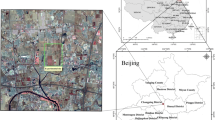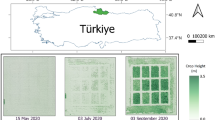Abstract
The estimation of nitrogen concentration from remotely sensed data has been the subject of some work. However, few studies have addressed the effective model for monitoring nitrogen status at canopy level using Support Vector Machines (SVM). The present study is focused on the assessment of an estimation model for nitrogen concentration of rape canopy with hyperspectral data. Two types of estimation model, the traditional statistical method based on stepwise linear regression (SLR) and the emerging computationally powerful techniques based on support vector machines were applied The Root Mean Square Error (RMSE) and T values were used to assess their predictability. The results show that a better agreement between the observed and the predicted nitrogen concentration were obtained by using the SVM model. Compared to the SLR model, the SVM model improved the results by lowering RMSE by 11.86–21.13 %, and by increasing T by 20.00–29.41 % for different spectral transformations. The study demonstrated the potential of SVM to estimate nitrogen concentration using canopy level hyperspectral data and it was concluded that SVM may provide a useful exploratory and predictive tool when applied to canopy-level hyperspectral reflectance data for monitoring nitrogen status of rape.


Similar content being viewed by others
References
Abdel-Rahman, E. M., Ahmed, F. B., & van den Berg, M. (2010). Estimation of sugarcane leaf nitrogen concentration using in situ spectroscopy. International Journal of Applied Earth Observation, 12(1), 52–57.
Chauchard, F., Cogdill, R., Roussel, S., Roger, J. M., & Bellon-Maurel, V. (2004). Application of LS-SVM to non-linear phenomena in NIR spectroscopy: development of a robust and portable sensor for acidity prediction in grapes. Chemometrics and Intelligent Laboratory Systems, 71, 141–150.
Diker, K., & Bausch, W. C. (2003). Potential use of nitrogen reflectance index to estimate plant parameters and yield of maize. Biosystems Engineering, 85, 437–447.
Durbha, S. S., King, R. L., & Younan, N. H. (2007). Support vector machines regression for retrieval of leaf area index from multiangle imaging spectroradiometer. Remote Sensing of Environment, 107, 348–361.
Foody, G. M. (1995). Using prior knowledge in artificial neural network classification with a minimal training set. International Journal of Remote Sensing, 16, 301–312.
Grossman, Y. L., Ustin, S. L., Jacquemoud, S., Sanderson, E. W., Schmuch, G., & Verdebout, J. (1996). Critique of stepwise multiple linear regression for the extraction of leaf biochemistry information from leaf reflectance data. Remote Sensing of Environment, 56, 182–193.
Haboudane, D., Miller, J. R., Tremblay, N., Zarco-Tejada, P. J., & Dextraze, L. (2002). Integrated narrow-band vegetation indices for prediction of crop chlorophyll content for application to precision agriculture. Remote Sensing of Environment, 81, 416–426.
Huang, Z., Turner, B. J., Dury, S. J., Wallis, I. R., & Foley, W. J. (2004a). Estimating foliage nitrogen concentration from HYMAP data using continuum removal analysis. Remote Sensing of Environment, 93, 18–29.
Huang, J. F., Wang, F. M., Wang, X. Z., Tang, Y. L., & Wang, R. C. (2004b). Relationship between narrow band normalized deference vegetation index and rice agronomic variables. Communications in Soil Science and Plant Analysis, 20, 2689–2708.
Im, J., & Jensen, J. R. (2008). Hyperspectral remote sensing of vegetation. Geography Compass, 2, 1943–1961.
Jacquemoud, S., Verdebout, J., Schmuck, G., Andreoli, G., & Hosgood, B. (1995). Investigation of leaf biochemistry by statistics. Remote Sensing of Environment, 54, 180–188.
Karimi, Y., Prasher, S. O., Patel, R. M., & Kim, S. H. (2006). Application of support vector machine technology for weed and nitrogen stress detection in corn. Computers and Electronics in Agriculture, 51, 99–109.
Martin, S., Clement, A., & Joachim, H. (2005). Remote sensing of forest biophysical variables using HyMap imaging spectrometer data. Remote Sensing of Environment, 95, 177–194.
Matsuda, S., Vert, J., Saigo, H., & Ueda, N. (2005). A novel representation of protein sequences for prediction of subcellular location using support vector machines. Protein Science, 14, 2804–2813.
Pinter, P. J., Hatfield, J. L., Schepers, J. S., Barnes, E. M., Moran, M. S., Daughtry, C. S., et al. (2003). Remote sensing for crop management. Photogrammetric Engineering & Remote Sensing, 69, 647–664.
Suykens, J. A. K., & Vandewalle, J. (1999). Least squares support vector machine classifiers. Neural Processing Letters, 9(3), 293–300.
Suykens, J. A. K., Van Gestel, T., de Brabanter, J., de Moor, B., & Vandewalle, J. (2002). Least squares support vector machines. Singapore: World Scientific Publishing.
Thenkabail, P. S., Smith, R. B., & Pauw, E. D. (2000). Hyperspectral vegetation indices and their relationships with agricultural crop characteristics. Remote Sensing of Environment, 71, 158–182.
Vapnik, V. (1995). The nature of statistical learning theory. Berlin: Springer.
Wang, F., Hang, J., & Zhou, Q. (2008). Optimal waveband identification for estimation of leaf area index of paddy rice. Journal of Zhejiang University Science B, 9, 953–963.
Wang, Z. J., Wang, J. H., Liu, L. Y., Huang, W. J., Zhao, C. J., & Wang, C. Z. (2004). Prediction of grain protein content in winter wheat (Triticum aestivum L.) using plant pigment ratio (PPR). Field Crops Research, 90, 311–321.
Wu, D., He, Y., Feng, S., & Sun, D. (2008). Study on infrared spectroscopy technique for fast measurement of protein content in milk powder based on LS-SVM. International Journal of Food Engineering, 84, 124–131.
Yang, F., Zhang, B., & Song, K. (2007). Hyperspectral estimation of corn fraction of photosynthetically active radiation. Agricultural Sciences in China, 6, 1173–1181.
Zhang, J. H., Wang, K., Bailey, J. S., & Wang, R. C. (2006). Predicting nitrogen status of rice using multispectral data at canopy scale. Pedosphere, 16(1), 108–117.
Acknowledgments
We gratefully thank Xiuzhen Wang, La Chen, Qiuxiang Yi and Xiaohua Yang for collecting the hyperspectral remote sensing data and oilseed rape sample data. This study was supported by the Natural Science Foundation of China (41171276, 51109183), and the Specialized Research Fund for the Doctoral Program of Higher Education of China (20110101120036).
Author information
Authors and Affiliations
Corresponding author
Appendix: LS-SVM algorithm
Appendix: LS-SVM algorithm
In this section, the LS-SVM algorithm is discussed briefly. It was developed to solve the regression problem defined as follows: \( \{ x_{i} ,y_{i} \}_{i = 1}^{N} \), where \( x_{i} \in X \subseteq {\mathbb{R}}^{n} \) is the ith input data point in input space and \( y_{i} \in Y \subseteq {\mathbb{R}} \) is the corresponding output value. The aim is to model the relationship between the input and output data points by a LS-SVM regression model. Equation 5 is linear in a higher dimensional feature space.
where w is a vector in feature space, \( \varphi (x) \) is a non-linear mapping from input space to a higher dimensional feature space, b is the bias term. In LS-SVM, the following optimization problem is formulated by
Subject to the equality constraints
where γ is the regularization factor, which balances the model’s complexity and the training errors, and \( e_{i} \) is the error variable. The solution is obtained after constructing the Lagrangian equation
where \( \alpha_{i} \) are the Lagrange multipliers. By solving this optimization problem, the coefficients \( \alpha_{i} \) and b can be determined by the following solution:
where \( K(x,x_{i} ) \) is the so-called kernel function with which the input vector can be mapped implicitly to a high-dimension feature space. The type of kernel and kernel function parameters selected are usually based on domain knowledge of where they are to be applied, and they should also reflect the distribution of input values of the training data (Durbha et al. 2007). Common examples of kernel functions include linear, polynomial, RBF and multi-layer perceptron.
Rights and permissions
About this article
Cite this article
Wang, F., Huang, J., Wang, Y. et al. Estimating nitrogen concentration in rape from hyperspectral data at canopy level using support vector machines. Precision Agric 14, 172–183 (2013). https://doi.org/10.1007/s11119-012-9285-2
Published:
Issue Date:
DOI: https://doi.org/10.1007/s11119-012-9285-2




